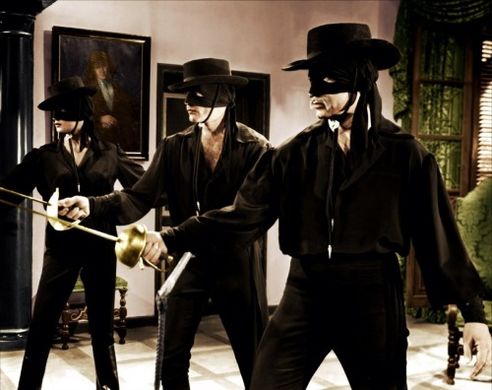PHENOMENALITY: *uncanny*
MYTHICITY: *fair*
FRYEAN MYTHOS: *adventure*
CAMPBELLIAN FUNCTION: *sociological*
This "Paella western," filmed mostly in Spain but purporting to take place in 1830s Mexico, has been seen under the dull title "Sword of Zorro." But a number of 1963 lobby cards play up the image of three sword-wielding cavaliers, one of them female, and this is certainly the most noteworthy aspect of this obscure movie-- even though the viewer doesn't see the trio until the film's end.
That gimmick aside, SWORDS is a better take on the Zorro mythos than director Ricardo Blasco's second and last take on the myth, 1965's BEHIND THE MASK OF ZORRO. The 1998 MASK OF ZORRO labored to make its "Zorro 2.0" into a citizen of Mexico rather than of Spain, but SWORDS got there first. Young Diego is not a noble cavalier, but a Mexican child whose parents are killed by a local tyrant. Diego is then raised by another Mexican family, alongside that family's blood daughter Maria (Mikaela Wood). When Diego is about six or so, he witnesses a cadre of the tyrant's guards chase a fugitive into his adopted family's house. Is the older man some previous Zorro? He's never called that, but while fighting with the tyrant's soldiers, the man carves a "Z" in the forehead of one opponent. The soldiers accidentally kill Diego's adoptive mother, which incites in the young boy a desire to fight evil.
In his manhood Diego (Guy Stockwell) assumes the identity of the black-masked Zorro and begins preying upon the nasty aristocrats, terrorizing the bumbling soldiers with his heroic mastery of sword and whip. For good measure, a young female named Virginia (Gloria Milland) travels to Zorro's city to marry the governor, who's expressly said to be old enough to be her father. Virginia is charmed by both Diego and Zorro but the script doesn't bother doing much with the old "girl hates the hero's phony coward-persona."
SWORD is pretty much Stockwell's film all the way, since no other performers get any standout moments. But Stockwell is good for all that he never again played a role similar to this one. Stuntwork and dialogue are decent. The end-gimmick, in which Real Zorro is joined by two Assistant Zorros, smacks of the original novel, in which the hero had a small band of revolutionaries in his service. Here, the Extra Two Zorros are introduced so suddenly that I didn't even follow who the Second Male Zorro was. The very last shot lingers on the face of Female Zorro Maria, who seems to be a little sad that her non-brother Diego has won the heart of Virginia. Given Diego's adoptive status I wondered if this Zorro might have a fling with a non-blood sibling, but that final shot is the only scene that suggests any of the filmmakers considered the notion.

No comments:
Post a Comment